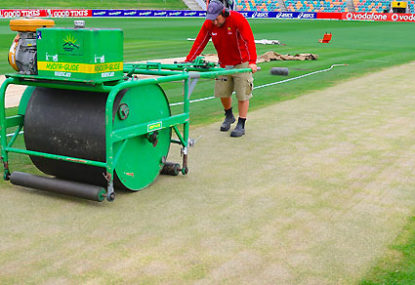The All Time XI For All Time: West Indies
Through electric bowling, dashing batting and acrobatic fielding the West Indies made themselves one of the most popular teams throughout history.

The game of cricket revolves around a flattish strip mown and rolled in the middle of the ground. Set the boundary ropes up 70 metres away and you can play a game.
Put in some stands and people can watch.
That is the simplicity of cricket, especially T20 Cricket, and that’s the ace cricket has up its sleeve.
People can play T20 anywhere in the world and have fun doing it.
Cricket can be played anywhere that grows grass in any of the three forms, and while T20 may start out as the most playable form in new countries as they start to build their game, so Tests and 50 over games will also become popular as time goes on.
Now the ‘track’ itself over the centuries has turned into an art form.
They can be made of ants’ nests, clay, red clay, dustbowls, green seamers (which I love), hard slightly green-tinged tracks, hard brown tracks, hard feather beds.
There are pitches guaranteed to break up, pitches with trampoline bounce, pitches dropped in that last as long as a block of flats.
The curators and groundsmen put blood, sweat and tears into their pitches, are proud of what they roll out and do a magnificent job for the game.
In the three forms of the game that are played today those men have a huge task and are worth their weight in platinum (gold’s only $1266 p.o.).
I noticed a shot on the Cricket Australia website that pictured Darren Lehmann standing beside what looked like a village green or common somewhere in England.
It was so green, ‘Shrek’ blended into the background.
It was actually the Centurion wicket for the first Test between Australia and South Africa.
If the bowlers pitch up on that track, get your mouth guards in, helmets on, as well as your neck brace, chest protectors, rib protectors, box, thigh guards, pads and reinforced steel cap boots.
Can you imagine Dale Steyne or Mitchell Johnson on that? Not to worry, that’s what batsmen get paid for.
It got me to thinking how much wickets play a part in the great game these days.
Test Cricket has become more of a five day classic than ever under the ICC.
The tracks are generally bone dry and hard because they want wickets that bring people to the game for the full five days – they sell more ice-creams that way.
Because of that, the bowlers have had to adjust hugely and I must say they have done a fantastic job.
We are more result driven. We want wins, not draws. And once more we are at the mercy of the groundsmen.
In India, the pitches rarely seam. They spin and stay low, unless they break up. Batsmen – well, Indian batsmen – dominate… mostly.
And if you were speaking hypothetically you would have to say home teams have wickets prepared that suit them first and the others can please themselves, or work a lot harder for their bacon.
English seamers, Australian bouncers, South African combination of seam and bounce, Sri Lankan and Pakistani turners, New Zealand firm and slowers, West Indian minefields and so on.
The hunt is always on for fielding teams to have the correct variety of seam bowlers, bouncing bowlers, spin bowlers, left and right arm, bowlers who vary pace-line-over and around.
Now to facilitate lots of runs and sixes, one day games and T20 have flat, hard wickets prepared in the main. The boundary ropes come in to 60-65 metres, the scoring rates climb from three an over up to as high as 10.
It would be safe to say that preparing a wicket to suit all three forms in different countries would be challenging, and maybe if we prepared the same sorts of wickets everywhere, we might as well play on concrete.
But Test, T20 and one day cricket can be played on a similarly flat surface that is durable. If it were the rule that all International Cricket under ICC control had that one consistency, both teams would have an even shot.
But I think the wicket is the key to even competition in cricket and whether we play in Canada, China, Russia, Europe, the sub continent or Australia, if we have a set of standards for curators and groundsmen, we have outcomes which are not determined by where the game is played.